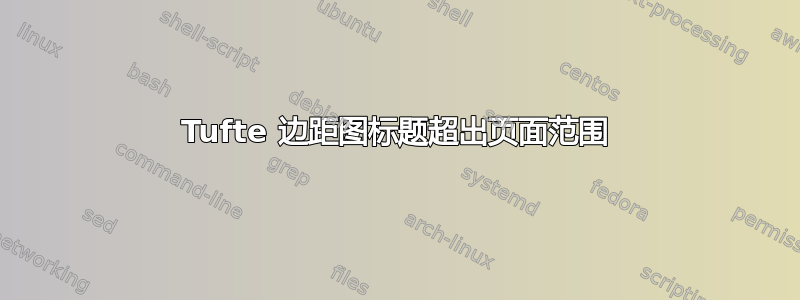
图 3.2 的标题显示在页面之外,无法阅读。如何避免这种情况。

以下是代码:
\documentclass[marginals=raggedouter,notoc]{tufte-book}
\setcounter{secnumdepth}{3}
\setcounter{tocdepth}{3}
\usepackage{graphicx}
\usepackage{amsmath}
\usepackage{amssymb}
\hypersetup{colorlinks}
\fancypagestyle{plain}{}
\begin{document}
\maketitle
\tableofcontents
For each angle $n \theta_k$ to be admissible for a lossless rotation, the region must have a radial symmetry in $\theta_k$. This eliminate most shapes from consideration. In fact, only circles (and perhaps circular saws) remains. For simplicity, we will assume that only circles are permissible.
Let us look at potential candidates.
\begin{marginfigure}
\includegraphics[width=\textwidth]{fig-circle-radial-subdivisions}
\caption{A circle that is radially subdivided. Notice how the area of the subdivisions are not equal. Per area, more data can be encoded in the center rings of the circle than on the edge rings.}
\label{fig:circle-radially-subdivided}
\end{marginfigure}
Figure \ref{fig:circle-radially-subdivided} presents a circle with a discrete radial symmetry on angle $\theta_k$. This circle can be rotated without loss of information, but the sub-divisions are not of equal area. This would mean that more bits of data per area can be store around the origin than at the edge. This is not acceptable because we must be able to translate the origins of the axis in space and the initial choice of the origin is arbitrary. Status : rejected.
\begin{marginfigure}
\includegraphics[width=\textwidth]{fig-circle-square-subdivisions}
\caption{A circle that is radially subdivided. Notice how the area of the subdivisions are not equal. Per area, more data can be encoded in the center rings of the circle than on the edge rings.}
\label{fig:circle-sub-divided-wth-squares}
\end{marginfigure}
Figure \ref{fig:circle-sub-divided-wth-squares} presents a circle which is sub-divided according to a square lattice structure. For this
\end{document}
答案1
tufte-book对这些类型的图形的使用\marginpar,有一个名为的包marginfix试图改善\marginpars 的定位。但是,虽然它在下面的例子中完成了工作,小心,因为它在某些情况下与一起使用时显然会出现异常tufte-book,请参阅marginfix 软件包吞噬了一些边注。
marginfigure不过,正如 Fran 所提到的, (和) 环境有一个可选参数,margintable用于调整垂直位置。在下面的示例中,我\begin{marginfigure}[-5cm]首先使用了marginfigure,但根据您的喜好调整距离。
\documentclass[marginals=raggedouter,notoc]{tufte-book}
\setcounter{secnumdepth}{3}
\setcounter{tocdepth}{3}
\usepackage[demo]{graphicx}
\usepackage{amsmath}
\usepackage{amssymb}
% \usepackage{marginfix} % might work, but be careful
\hypersetup{colorlinks}
\fancypagestyle{plain}{}
\begin{document}
\maketitle
\tableofcontents
For each angle $n \theta_k$ to be admissible for a lossless rotation, the region must have a radial symmetry in $\theta_k$. This eliminate most shapes from consideration. In fact, only circles (and perhaps circular saws) remains. For simplicity, we will assume that only circles are permissible.
\vspace{28em}
Let us look at potential candidates.
\begin{marginfigure}[-5cm]
\includegraphics[width=\textwidth]{fig-circle-radial-subdivisions}
\caption{A circle that is radially subdivided. Notice how the area of the subdivisions are not equal. Per area, more data can be encoded in the center rings of the circle than on the edge rings.}
\label{fig:circle-radially-subdivided}
\end{marginfigure}
Figure \ref{fig:circle-radially-subdivided} presents a circle with a discrete radial symmetry on angle $\theta_k$. This circle can be rotated without loss of information, but the sub-divisions are not of equal area. This would mean that more bits of data per area can be store around the origin than at the edge. This is not acceptable because we must be able to translate the origins of the axis in space and the initial choice of the origin is arbitrary. Status : rejected.
\begin{marginfigure}
\includegraphics[width=\textwidth]{fig-circle-square-subdivisions}
\caption{A circle that is radially subdivided. Notice how the area of the subdivisions are not equal. Per area, more data can be encoded in the center rings of the circle than on the edge rings.}
\label{fig:circle-sub-divided-wth-squares}
\end{marginfigure}
Figure \ref{fig:circle-sub-divided-wth-squares} presents a circle which is sub-divided according to a square lattice structure. For this
\end{document}


